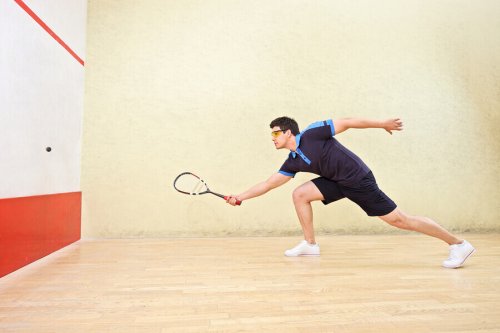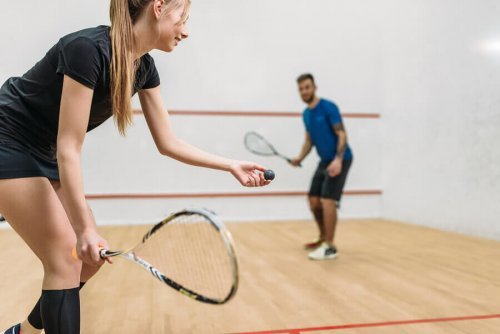Squash: Learn Everything About This Sport

Although its name is more similar to that of a water sport, squash is a kind of “tennis” that people play in front of a wall. In the following article, we’ll go over this sport’s main characteristics and rules.
What to know about squash
By definition, squash is a racket sport that’s practiced in indoor environments. Two players participate, who use a racket to hit a rubber ball of varying degrees of speed and bounce. The goal is for the ball to hit the frontal wall at least once before touching the ground.
The squash scoring system is as follows: players add a point when they win a play. The first to reach 11 points wins a game. In the event that the players are tied with 10 points each, the player who scores two consecutive points will win (12-10). In total, the match can have three or five games.
The purpose of the sport is for both players to return the ball to the front wall; the ball is allowed to bounce twice on the ground before hitting it. The last person to hit the wall with the ball successfully during a point is the one who wins the point. Keep in mind that the front wall has two lines, which is the area where the ball should hit.
The squash court has a length of 9.75 meters and a width of 6.40 meters. The front wall has a height of 4.57 meters.
As for the ball, it measures about 40 millimeters in diameter and weighs about 25 grams. It’s made of rubber and can have different degrees of bounce (dynamic level). To differentiate them, colors are used:
Double yellow dot, the professional squash ball
It’s for expert players, with very low rebound and extra slow speed. They use this ball for professional competitions.
Single yellow dot
For advanced players, with low bounce and slow speed.
Single red dot
Ideal for intermediate players, with high rebound and medium speed.

Single blue dot
It’s for those who are just starting to practice squash or for children. The bounce is very high and the speed is fast.
There are five international squash competitions: the World Open, the British Open, The World Series, the World International, and the World Challenger. The nationalities of the biggest players and winners of this sport are Pakistan, Egypt, Australia, France, and England. In these countries, the presence of squash is superior in relation to others.
How to play squash
It’s not necessary to become a professional and compete internationally. You can also choose squash as a cardio sport, to have fun with friends or to lose weight. Here are a few basic notions of the sport that can be useful:
1. Warm-up
When the squash match begins, the players enter the court together and warm-up for 5 minutes. This consists of throwing the ball to the wall and back to the other player without points. Thus, in addition, both adapt to the conditions of the court.
2. Services
The one who starts serving chooses the service box. Then, the player changes sides. A good service allows the game to continue. That’s why it’s so important to get it right.
3. Intervals
After warming up, the players have 90 seconds to start the game. This interval is also allowed when a player has to change clothes or when changing sides.
4. Squash racket
The squash racket is different from the one players use in tennis. In case you don’t have one yet, you can rent it in the same club or gym that has a pediment.
To hold it, place your hand so that the thumb and index fingers form a “V”. Don’t hold it tightly because that will make you prone to wrist injuries.

5. Court
The courts can be found in clubs dedicated solely to squash, in sports centers, or gyms. One of the rules to enter is to have sports shoes that don’t have dark soles since they leave marks on the floor.
The practice required is very important to play squash. The first thing you should learn is to hit the ball well. At first, it can be a bit difficult, even frustrating. You can train until you master the techniques and then play it with another person.
Although its name is more similar to that of a water sport, squash is a kind of “tennis” that people play in front of a wall. In the following article, we’ll go over this sport’s main characteristics and rules.
What to know about squash
By definition, squash is a racket sport that’s practiced in indoor environments. Two players participate, who use a racket to hit a rubber ball of varying degrees of speed and bounce. The goal is for the ball to hit the frontal wall at least once before touching the ground.
The squash scoring system is as follows: players add a point when they win a play. The first to reach 11 points wins a game. In the event that the players are tied with 10 points each, the player who scores two consecutive points will win (12-10). In total, the match can have three or five games.
The purpose of the sport is for both players to return the ball to the front wall; the ball is allowed to bounce twice on the ground before hitting it. The last person to hit the wall with the ball successfully during a point is the one who wins the point. Keep in mind that the front wall has two lines, which is the area where the ball should hit.
The squash court has a length of 9.75 meters and a width of 6.40 meters. The front wall has a height of 4.57 meters.
As for the ball, it measures about 40 millimeters in diameter and weighs about 25 grams. It’s made of rubber and can have different degrees of bounce (dynamic level). To differentiate them, colors are used:
Double yellow dot, the professional squash ball
It’s for expert players, with very low rebound and extra slow speed. They use this ball for professional competitions.
Single yellow dot
For advanced players, with low bounce and slow speed.
Single red dot
Ideal for intermediate players, with high rebound and medium speed.

Single blue dot
It’s for those who are just starting to practice squash or for children. The bounce is very high and the speed is fast.
There are five international squash competitions: the World Open, the British Open, The World Series, the World International, and the World Challenger. The nationalities of the biggest players and winners of this sport are Pakistan, Egypt, Australia, France, and England. In these countries, the presence of squash is superior in relation to others.
How to play squash
It’s not necessary to become a professional and compete internationally. You can also choose squash as a cardio sport, to have fun with friends or to lose weight. Here are a few basic notions of the sport that can be useful:
1. Warm-up
When the squash match begins, the players enter the court together and warm-up for 5 minutes. This consists of throwing the ball to the wall and back to the other player without points. Thus, in addition, both adapt to the conditions of the court.
2. Services
The one who starts serving chooses the service box. Then, the player changes sides. A good service allows the game to continue. That’s why it’s so important to get it right.
3. Intervals
After warming up, the players have 90 seconds to start the game. This interval is also allowed when a player has to change clothes or when changing sides.
4. Squash racket
The squash racket is different from the one players use in tennis. In case you don’t have one yet, you can rent it in the same club or gym that has a pediment.
To hold it, place your hand so that the thumb and index fingers form a “V”. Don’t hold it tightly because that will make you prone to wrist injuries.

5. Court
The courts can be found in clubs dedicated solely to squash, in sports centers, or gyms. One of the rules to enter is to have sports shoes that don’t have dark soles since they leave marks on the floor.
The practice required is very important to play squash. The first thing you should learn is to hit the ball well. At first, it can be a bit difficult, even frustrating. You can train until you master the techniques and then play it with another person.
All cited sources were thoroughly reviewed by our team to ensure their quality, reliability, currency, and validity. The bibliography of this article was considered reliable and of academic or scientific accuracy.
- Breslar, M. L. R. (1910, February 26). “Squash.” Notes and Queries. https://doi.org/10.1093/nq/s11-I.9.169-i
- Squash: un deporte de dinámica, reflejos e inteligencia. Conade. Gobierno Federal de México. http://conadeb.conade.gob.mx/Documentos/Publicaciones/Squash.pdf
This text is provided for informational purposes only and does not replace consultation with a professional. If in doubt, consult your specialist.








